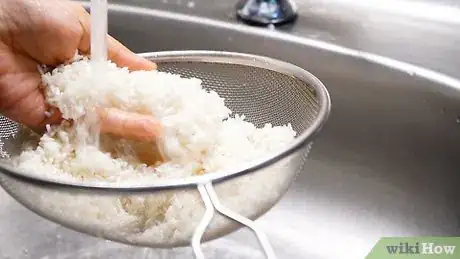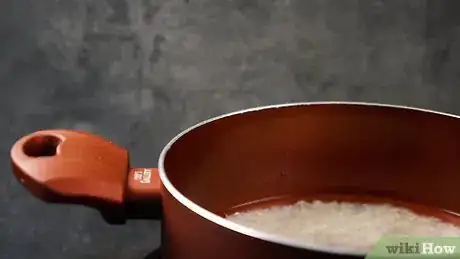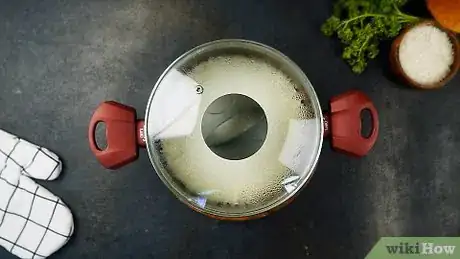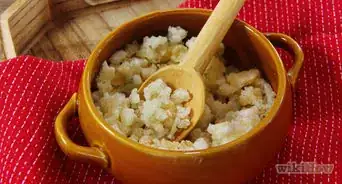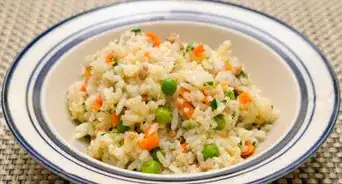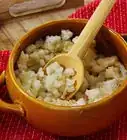This article was co-authored by JoAnna Minneci and by wikiHow staff writer, Dan Hickey. JoAnna Minneci is a Professional Chef based in the Nashville, Tennessee area. With more than 18 years of experience, Chef JoAnna specializes in teaching others how to cook through private cooking lessons, team-building events, and wellness and nutrition classes. She has also appeared in numerous television shows on networks such as Bravo and Food Network. Chef JoAnna received Culinary Arts training from the Art Institute of California at Los Angeles. She is also certified in sanitation, nutrition, kitchen management, and cost control.
There are 12 references cited in this article, which can be found at the bottom of the page.
This article has been viewed 221,190 times.
White rice is a simple staple when it comes to basic cooking and side dishes, but how easy is it to make without a rice cooker? It turns out a rice cooker isn’t necessary—making white rice in a pot on the stove gives just as great results. We’ve put together a handy guide to making the perfect white rice without a rice cooker to go with any meal. Keep scrolling to satisfy your craving!
Ingredients
- 2 cups (440 g) of white rice
- 3 cups (710 mL) of water
- 0.5 teaspoons (2.8 g) of salt (optional)
- 1 tablespoon (15 mL) of butter or oil (optional)
- 3 cups (710 mL) of chicken, beef, or vegetable broth (optional in place of water)
Makes 4 to 6 servings
Steps
Expert Q&A
-
QuestionWhat can you add to rice to give it flavor?
 JoAnna MinneciJoAnna Minneci is a Professional Chef based in the Nashville, Tennessee area. With more than 18 years of experience, Chef JoAnna specializes in teaching others how to cook through private cooking lessons, team-building events, and wellness and nutrition classes. She has also appeared in numerous television shows on networks such as Bravo and Food Network. Chef JoAnna received Culinary Arts training from the Art Institute of California at Los Angeles. She is also certified in sanitation, nutrition, kitchen management, and cost control.
JoAnna MinneciJoAnna Minneci is a Professional Chef based in the Nashville, Tennessee area. With more than 18 years of experience, Chef JoAnna specializes in teaching others how to cook through private cooking lessons, team-building events, and wellness and nutrition classes. She has also appeared in numerous television shows on networks such as Bravo and Food Network. Chef JoAnna received Culinary Arts training from the Art Institute of California at Los Angeles. She is also certified in sanitation, nutrition, kitchen management, and cost control.
Professional Chef Coconut milk, scallions, and fish sauce make for a great combo! Just keep adding each of those ingredients to taste. You can even sweeten the rice with a little bit or brown or palm sugar, if you'd like.
Coconut milk, scallions, and fish sauce make for a great combo! Just keep adding each of those ingredients to taste. You can even sweeten the rice with a little bit or brown or palm sugar, if you'd like. -
QuestionIf I add too much oil, does that effect the rice?
 wikiHow Staff EditorThis answer was written by one of our trained team of researchers who validated it for accuracy and comprehensiveness.
wikiHow Staff EditorThis answer was written by one of our trained team of researchers who validated it for accuracy and comprehensiveness.
Staff Answer wikiHow Staff EditorStaff AnswerIt depends on how much extra oil you add. A small amount won't have much of an effect, but a large amount will make the rice slippery and oily when finished. If you think you've added too much, strain out the oily water while the rice is simmering and add fresh hot water.
wikiHow Staff EditorStaff AnswerIt depends on how much extra oil you add. A small amount won't have much of an effect, but a large amount will make the rice slippery and oily when finished. If you think you've added too much, strain out the oily water while the rice is simmering and add fresh hot water. -
QuestionWhat sort of curry can I make with rice? Give me some ideas, please.
 wikiHow Staff EditorThis answer was written by one of our trained team of researchers who validated it for accuracy and comprehensiveness.
wikiHow Staff EditorThis answer was written by one of our trained team of researchers who validated it for accuracy and comprehensiveness.
Staff Answer wikiHow Staff EditorStaff AnswerWhite rice is very versatile and pairs well with any curry you'd like to make. Panang, red, yellow, or green curries are all tasty, popular options!
wikiHow Staff EditorStaff AnswerWhite rice is very versatile and pairs well with any curry you'd like to make. Panang, red, yellow, or green curries are all tasty, popular options!
Things You’ll Need
- 2-quart (1.9 L) pot with a lid
- Colander or sieve
- Wooden spoon
- Fork, chopsticks, or rice paddle
- Dish towel (optional)
References
- ↑ https://whatscookingamerica.net/pasta_rice_main/perfect-white-rice.htm
- ↑ https://www.thekitchn.com/yes-you-should-be-rinsing-your-rice-228083
- ↑ https://www.bbcgoodfood.com/videos/techniques/how-cook-rice-video
- ↑ https://www.realsimple.com/food-recipes/cooking-tips-techniques/cooking/cook-rice
- ↑ https://www.foodnetwork.com/recipes/patrick-and-gina-neely/perfect-rice-recipe-1938571
- ↑ https://www.wokandskillet.com/how-to-cook-rice-without-a-rice-cooker/
- ↑ https://whatscookingamerica.net/pasta_rice_main/perfect-white-rice.htm
- ↑ https://www.delish.com/cooking/a20089653/how-to-cook-rice/
- ↑ https://www.foodnetwork.com/how-to/articles/how-to-make-perfect-rice-a-step-by-step-guide
About This Article
To cook rice without a rice cooker, first measure out how much rice you want to cook and place it in a fine-mesh strainer. One cup of dry rice will make about three cups of cooked rice. Rinse the rice under running water until the water runs clear to remove excess starch. Then, transfer the rice to a pot and add 1 ½ cups (350 mL) of water for every 1 cup (200 g) of rice. This ratio will work for any type of rice. For firmer rice, use less water, like 1 ¼ cups (300 mL). For softer rice, use more water, like 2 cups (475 mL). Bring the water to a boil, then reduce the heat and cover the pot. Let the rice cook for about 20 minutes for white rice or 30-40 minutes if you’re cooking brown rice. Check the surface of the rice for small steam holes to make sure it’s done. Then, remove the pot from the heat and let the rice sit, covered, for 10 minutes. This allows the moisture in the pot to redistribute evenly throughout the rice so the texture is even. Finally, remove the lid and fluff the rice with a fork before serving. To learn how to season white rice, scroll down!
